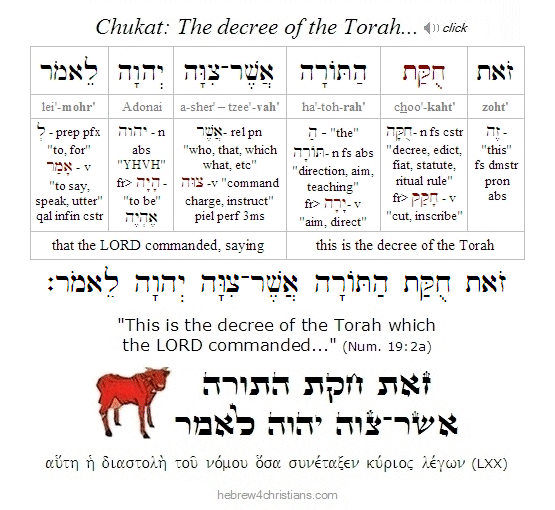|
[ Note: This week's Torah (Chukat) includes three amazing pictures of the coming of the Messiah of Israel: 1) the mysterious Red Heifer sacrifice, 2) the Striking of the Rock at Meribah, and 3) the image of the Bronze Serpent on a pole. It is certainly one of the most fruitful portions of Torah to share with your Jewish friends... ]
The Torah for this Shabbat (Chukat) begins with the description of the unusual ritual law of the parah adumah (red heifer). This ritual is considered "chok" within the Jewish tradition, meaning that it defies rational sense. In fact, the Talmud states that of all the taryag mitzvot (613 commandments), this is the only one that wise King Solomon could not fathom.
Why was this sacrifice so puzzling to King Solomon and the Jewish sages? Well, the sacrifice of the red cow just doesn't fit the pattern of any of the other sacrifices given in the Torah. It's a paradox, a puzzle, a question... Here are eight reasons why:
- It required a completely red cow - "without blemish, in which there is no defect (mum)." This is the only sacrifice in Torah that specifically required an animal of a particular color (symbolic of sin).

- It was the most unique sacrifice in the Torah. Unlike other animals that could be offered to the LORD, a completely red cow was extremely rare and one of a kind.
- It was the only sacrifice where all the rituals were carried out outside of the camp (and later, outside the Temple precincts). That is, the "blood applications" of this sacrifice occurred in a location apart from the Levitical altar.
- It is the only sacrifice of blood in the Torah of Moses. In other words, the blood of the red cow was not drained out but rather was burned in the fire.
- It was the only sacrifice that ritually contaminated the priest who offered it, but made the one who was sprinkled by it clean.
- The items used to cleanse tzaraat ("leprosy") were burned along with the sacrifice. In other words, the sacrifice would incorporate the means of cleansing from defilement and uncleanness.
- It was the only sacrifice where the ashes were preserved and used (other sacrifices required the ashes be disposed outside of the camp). The ashes of the sacrifice were gathered and mixed with water to create the "water of separation" (mei niddah). Note that the word "separation" (niddah) refers to menstrual impurity and harkens to Zechariah 13:1: "On that day there shall be a fountain opened for the house of David and the inhabitants of Jerusalem, to cleanse them from sin and from niddah."
- It was the only sacrifice in Torah that explicitly cleansed from the contact with sin and death. Anyone (or anything) that came into contact with a corpse (the embodiment of sin and death) was required to be purified using the mei niddah.
The Talmud says there were nine red heifers (parot hadumot) offered so far on behalf of the Jewish people, and that a tenth (and final) Red Heifer will be burned by the Mashiach at the time of the rebuilding of the Temple (Mishnah, Parah 3:5). However, these sages clearly did not understand that Yeshua is the fulfillment and substance of this type of sacrifice (Heb. 9:11-28). Like the mysterious Red Cow, Yeshua was completely without sin or defect (2 Cor. 5:21; John 8:46); He was utterly unique (John 1:14,18; Matt. 17:5, etc.); He was sacrificed outside the camp (Heb. 13:13); He became contaminated by offering Himself as sin for us (2 Cor. 5:21); His blood was part of the sacrifice (Eph. 2:13, Heb. 9:14, 1 Pet. 1:19, etc.); His sprinkling makes us clean (1 Pet. 1:2; Heb. 12:24; Rev. 1:5); and the "water of separation" that His sacrifice created is the means by which we are made clean from the impurity of sin and death (Eph. 5:25-6; Heb. 10:22).
The sages of the Talmud had it partly right.... Yeshua's sacrifice as our "Red Heifer" indeed preceded the "rebuilding" of the Temple (John 2:19) - though this Temple is one made "without human hands" by the power of the Holy Spirit (Matt. 26:26-28, 1 Cor. 12:27, Eph. 4:4,11-12, Col. 1:24, etc.). The followers of the Messiah are now part of the Temple of His Body (1 Cor. 3:16, 12:27) and are called "living stones" (1 Pet. 2:5). The sacrifice of the tenth Red Heifer -- Yeshua -- instituted a new priesthood after the order of Malki-Tzedek (Heb. 5:10 with 1 Pet. 2:5) that replaces the older Levitical priesthood of Aaron (Heb. 13:10). Beloved, we have been cleansed from our sins by a better sprinkling than that which the tent of Moses could afford (Matt. 26:28, Heb. 9:14, 12:24, Eph. 1:7, 1 Pet. 1:2,18-19, Rom. 5:9; Col. 1:14, 1 John 1:7, etc.).
Note: The Parah Adumah ("Red Heifer") sacrifice is a PICTURE of the power of Yeshua's sacrifice to clease us from sin and death. It is an IMAGE, a METAPHOR, a SIMILE. There are hundreds of these pictures in Scripture, and Yeshua Himself used them all the time: "I am the DOOR...," "I am the TEMPLE...," "I am the Bread of Life/Living Water...," etc.
Related Topics:
|




